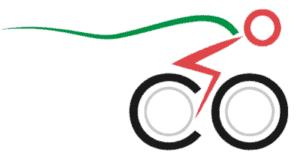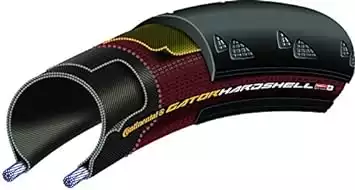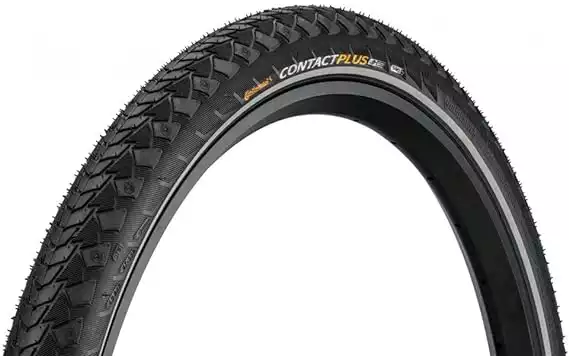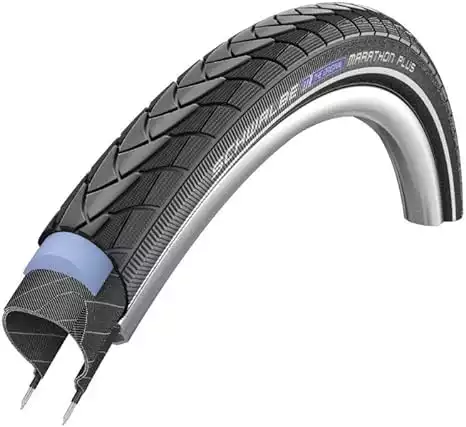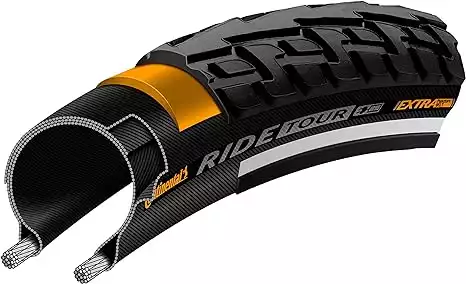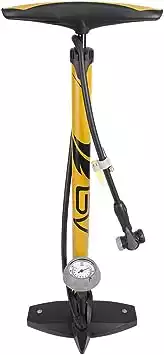Reliability is one of the most important characteristics of a commuter bike, and having good quality tires that prevent you from getting flats all the time allows you to ride safely and reliably. Most commuter bikes come with 700c tires, but unfortunately, many of them don’t have good puncture protection out of the box. I tested the best commuter tires in the past few years and ranked them for you.
The Schwalbe Marathon Plus, the Continental Contact Plus and the Continental Ride Tour are outstanding 700c commuter tires. They all have good puncture protection, decent grip on the road and reflective side walls for extra visibility even on dark days.
| Continental GatorSkin | Continental Contact Plus | SCHWALBE Marathon Plus | Continental Ride Tour | |
| Puncture protection | 5/10 | 7/10 | 10/10 | 9/10 |
| Grip | 7/10 | 8/10 | 7/10 | 10/10 |
| How well does it roll | 10/10 | 8/10 | 7/10 | 6/10 |
| Reflective detail for safety | No | Yes | Yes | Yes |
| Best for | Paved roads | Urban and country | City and urban roads | Urban and light off-road |
Best slick tires
These tires are pretty much the gold standard for slick commuter tires. They offer the least rolling resistance, which makes them suitable for speedy commutes on your road bike. Because they lack treads and good sidewall protection, they are only suitable for paved roads and urban riding.
These tires are best suited for road bikes. This is not the best type of tire for you if you have a hybrid commuter, a fitness bike, a gravel bike, or a city bike.
Electric bikes built for everything and priced for everyone. Shop Rad Power Bikes, America's #1 electric bike brand. Get out. Go further. Ride Rad.
This is also not the best tire for maximum puncture protection, but it offers a good balance for those who want to commute reasonably fast.
Best versatile tires for urban and country roads
This tire performs well on a variety of road surfaces: tarmac, gravel, countryside as well as forest trails thanks to its universal tread pattern. It offers low rolling resistance, which allows you to ride fast. It also has reflective sidewalls for extra visibility at night.
I love this tire. In fact, this is the one that I ride most of the time. It offers excellent grip on different surface types: it performs great on paved roads and off-road as well. I never had a puncture with this tire after several years of riding it.
Best puncture-resistant tires and best all-rounder
It doesn't get any better than the Schwalbe Marathon Plus when it comes to puncture resistance!
I use this tire on my wife’s e-bike. It is pretty much the gold standard for general-purpose urban commuter tires. They are somewhat heavy, but the weight doesn’t make them sluggish. I wanted to test them on my commuter as well, so I purchased another set.
They come with excellent puncture protection and reflective sidewalls and offer very good riding comfort. They are the tires to get if you’re looking for something you can put on your bike and not think about for months or even years.

I found that Schwalbe tires seem to wear faster than Continental tires. This may have been only my personal experience, but it’s worth mentioning.
Best budget tires
This is a solid tire from Continental if you don't want to spend a lot of money, but you want good puncture protection.
I used the Continental Ride Tour on my commuter for the first 4000+ miles, and I absolutely love it!
It’s a reasonably fast tire that allows me to cruise at 18-20 mph on flat parts without any problem. It has a good grip even when riding off-road.
I’ve used it on forest trails and all kinds of surfaces. Snow isn’t a problem, either. It has reflective sidewalls for extra side visibility at night. It shows some signs of wear at the sidewalls (minor cracks), but it is a solid budget option.

If you don’t care to have the absolute best tire, but you want the best bang for your buck, this is the one to get.
Why 700c tires are great for commuting
Since almost every new bike comes with inner tubes and tires (aka clincher tires), and I believe that this is the best option for most bike commuters, I don’t include tubular or tubeless tires in my recommendations. In other words, if you’re a regular Joe, just like me, read on.
700c refers to the tire diameter of your wheel, and it is written on the sidewall of your tire. It is also referred to as a 28” tire.
It is the most common tire size in hybrid, road, gravel and touring bikes and they are the perfect size for bike commuting too for a good reason. Wheels with 700c tires strike a good balance of speed, handling in corners, maneuverability, and comfort.
However, not all 700c tires have been created equal, and some offer features that others lack. Let’s focus on what you must look for as a commuter.
Features of a good commuter tire
Look for the following features when buying:
- Good grip in all weather conditions on a variety of surfaces. Some tires are great on paved roads but suffer on cobbles or even light gravel.
- A width of at least 28 mm. The wider a tire, the better it absorbs road imperfections. This is important for city and urban riding where you come across potholes, bumps, rail tracks, road debris, uneven road surfaces etc. Go for a 32mm wide tire if your bike has enough clearance.
- Good puncture resistance. This is essential if you don’t want to spend time on the roadside fixing flats.
- Reflective sidewalls for extra visibility at night. Anything that makes you more visible is great!!!
- Decent rolling resistance (avoid tires wider than 35mm, as they will be too heavy and feel sluggish)
The width and the tread pattern have the biggest impact on your comfort and riding experience. The weight also plays a role, although for most commuters, it needs to be only a secondary consideration. All the tires I recommend are light enough for commuters.
Tire width
Width is the most important factor that impacts your riding comfort. The wider a tire the more air volume it contains and the more comfortable it is to ride because the better it absorbs road imperfections. Wider tires don’t need to run on such high pressures as narrow tires, which gives them a cushy feeling.
Tire width is measured in mm. Most 700c tires run from 23 mm to 50 mm.
- 23 – 25 mm tires are regarded as narrow tires and are used on road bikes for racing. They are fast-rolling tires. They need to be inflated to high pressure to avoid punctures, so they are not very comfortable riding.
- 28 – 35 mm tires are the most versatile. They offer superior comfort with no noticeable added rolling resistance (rolling resistance makes it harder to pedal). They can withstand some light off-road or gravel riding.
- 35+ mm tires are noticeably heavier and slower. They are typically used for more heavy-duty off-road riding. This is typically the threshold beyond which extra cushioning becomes more hindrance than provides comfort for the typical commuter.
Before you decide to get a really wide tire, make sure that your bike has enough clearance. This means that there is enough room to fit your tire between the fork. Some road bikes can accommodate tires of maximum 28 mm and cyclocross bikes usually have a tire clearance of 33 mm.
Tread pattern
700c tires are either slick, semi-slick or treaded.
Slick tires have no tread patterns. They look like an inner tube on the rim. There is no extra rubber added for knobs or treads to keep the weight down to a minimum so they can maximize speed. Slick tires perform best on paved roads. They hug the road very well.
Slick tires struggle in providing grip when riding off-road. They lack knobs or treads that can interlock with anything other than a perfectly smooth road.
The Continental Gatorskin is one of the most popular slick tires among commuters. If you know you will never go off-road with your bike they are a solid option for paved roads.
Tires with treads come in a wide variety. Some treads are less aggressive, suitable for both road and light gravel (aka semi-slicks) others have more pronounced tread patterns for extra off-road grip. If you have a trekking bike, hybrid bike, gravel bike, cyclocross bike, or touring bike, tires with treads make sense. Most commuters will find a tire with treads most useful for their ride.
Mountain bikes and fat bikes have knobs, which allows them to ride even in muddy conditions. Unless you commute through muddy forest trails on an MTB you don’t need knobby tires.
Weight
Bike tires for commuting usually weigh between 200 and 1000 grams. The lighter end of the scale offers more speed, but often lacks the extra puncture protection that heavier tires can offer.
A lighter tire is usually faster, but from an average bike commuter’s perspective, weight doesn’t make a huge difference. You can also see it in my test video above.
Reflective sidewall
I love this feature on my commuter tires because I know that I’m visible from for any car approaching me from the side in an intersection if it has the lights on.
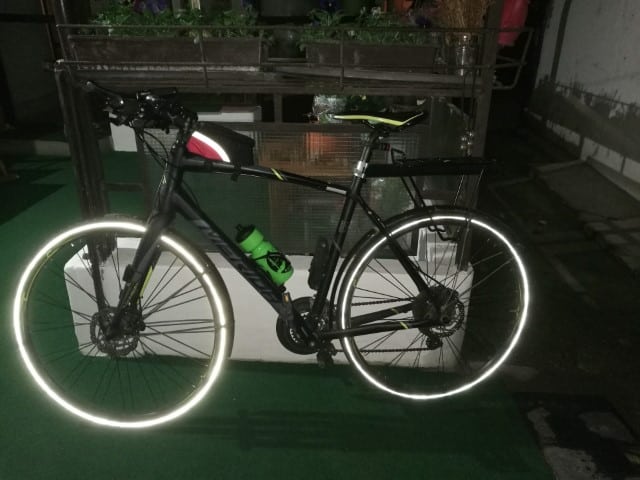
Tire care for longevity
To extend the lifespan of your tire, you should keep in mind two things:
Get the proper tire that suits your commute type, especially if you ride on gravel or poor-quality roads. Slick tires tend to suffer when used on rocks or off-road. If you have any demanding segment on your commute, opt for tires with treads.
Check tire pressure regularly, maybe once a week or every two weeks. This is important, because low tire pressure can result in pinch flats when you hit potholes, cross tram tracks, get onto curbs, ride on cobble, etc.
This floor pump is compatible both with Presta and Schrader valves, which means that you can use it with MTB tires as well as road bike tires.
The manufacturer specifies the tire pressure range within which it’s safe to operate the tires. For best flat protection, aim for the higher end of the range. Don’t just guess the pressure, but use a pump with a gauge. It’s one of the best purchases you can make.
Conclusion
Choosing a good 700c commuter tire is relatively easy, and there are a few solid choices available. I recommend you not to cheap out on bike tires, as they not only affect your riding speed and comfort, but a poor quality bike tire can be a source of a lot of frustration and even accidents.
Happy Riding!
